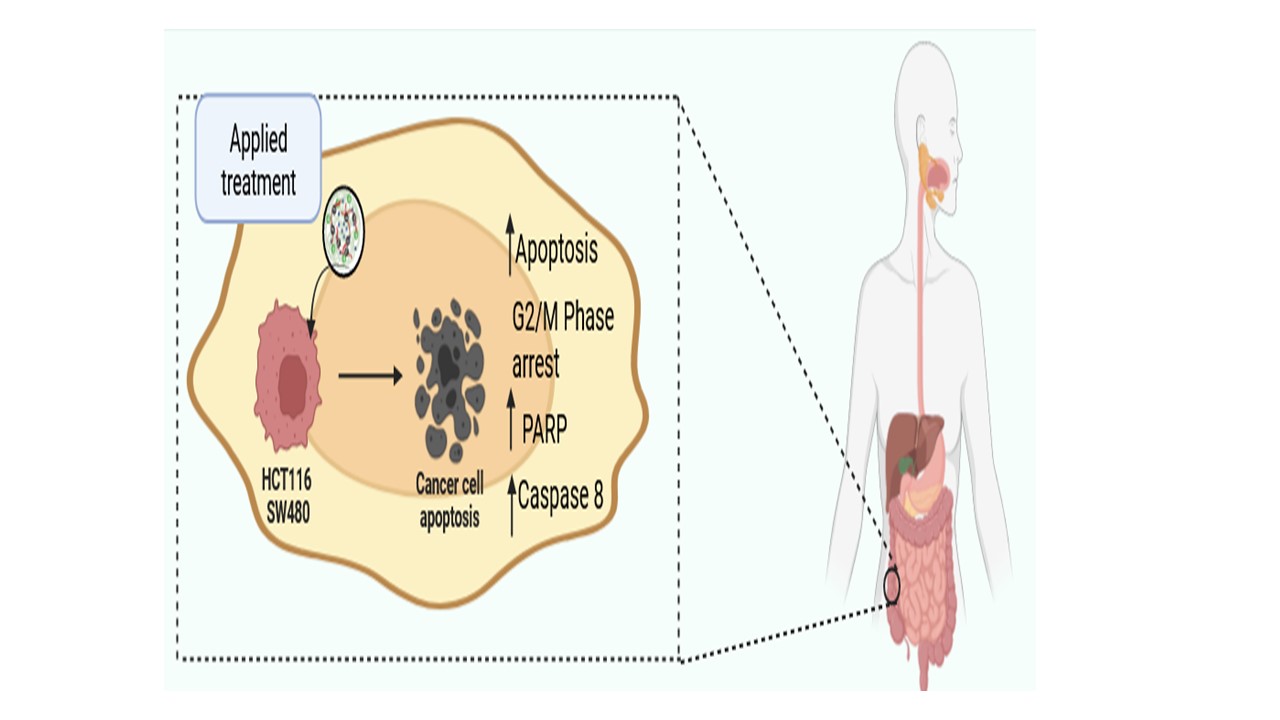Formulation and Delivery - Chemical
(M1330-01-01) The Anti-Colon Cancer Potential of Succinylated Curcumin Encapsulated in Mannosylated Chitosan
Monday, October 21, 2024
1:30 PM - 2:30 PM MT

Nashiru Billa, PhD
PROFESSOR
Qatar University
Doha, Ad Dawhah, Qatar- SI
Sourour Idoudi, MS
Ms
Qatar University
Doha, Ad Dawhah, Qatar
Presenting Author(s)
Main Author(s)
Purpose: Colon cancer (CRC) is the second leading cause of death and the third most diagnosed cancer worldwide. Curcumin (CUR) from Curcuma longa has potent anti CRC activity. However, its use is limited by its low solubility, bioavailability, and its instability. We addressed some of these limitations through synthetic derivatization and nano-formulation.
Methods: Our study aimed to conjugate CUR to succinic anhydride (SA) and to optimize this conjugate (CUR.SA) in loaded mannose-functionalized chitosan nanoparticles (CUR.SA-CMNPs). Physical and structural characteristics of the formulated nanoparticles are investigated. The anti-tumor activity of these nanoparticles was assessed in vitro using two CRC human cell-lines (HCT116 and SW480) and one non-malignant colorectal cancer human cell-line (CCD841 CoN cells).
Results: Physical and chemical characteristics analysis using FTIR, NMR spectra and XRD confirmed the formation of the CUR.SA conjugate and assembly of CUR.SA-CMNPs. Size analysis disclosed relatively higher size (268 ± 6 nm) of CUR.SA-CMNPs and of CUR-CMNPs (342 ± 4 nm) compared to unloaded nanoparticles (CMNPs) (110 ± 2 nm). Storage and stability studies in colonic conditions confirmed the stability of CUR-CMNPs and CUR.SA-CMNPs over 28 days. Cytotoxicity studies using CCK-8 assay indicated that both CUR-CMNPs and CUR.SA-CMNPs have a dose and time-dependent toxicity towards malignant colorectal cancer human cell-lines (HCT116 and SW480), and are more cytotoxic compared to free CUR or CUR-SA. Further, Western blotting analyses confirmed the induction of apoptosis through activation of Caspase signaling in treated cells. No cytotoxic effect was observed on non-malignant colorectal cancer human cell-lines (CCD841 CoN cells), upon treatment with CUR-CMNPs and CUR.SA-CMNPs. Our results illustrate the safe profile of CUR-CMNPs and CUR.SA-CMNPs and their potential application for cancer therapy.
Conclusion: Based on our findings, we may conclude that our curcumin nanoparticle formulations hold a promising anti-tumor effect in colorectal cancer. Further investigations are needed to confirm the anti-tumor potential of these nanoparticles in colorectal cancer and to better understand their mechanism of action.
References: Studies on anti-colon cancer potential of nanoformulations of curcumin and succinylated curcumin in mannosylated chitosan. Sourour Idoudi, Takwa Bedhiafi, Fairooz Sahir, Yousef Hijji, Shahab Uddin, Maysaloun Merhi, Said Dermime, Nashiru Billa. International Journal of Biological Macromolecules (2023), https://doi.org/10.1016/j.ijbiomac.2023.123827
A novel approach of encapsulating curcumin and succinylated derivative in mannosylated- chitosan nanoparticles, Sourour Idoudi, Yousef Hijji, Takwa Bedhiafi, Hesham M. Korashy, Shahab Uddin, Maysaloun Merhi, Said Dermime and Nashiru Billa, Carbohydrate Polymers (2022), https://doi.org/10.1016/j.carbpol.2022.120034
Acknowledgements: We acknowledge Qatar University for funding this study (Grant number IRCC-2021-006).
.jpg)
Figure 1: Graphical representation of the prepared nanoparticles

Figure 2: Graphical representation of the anticancer assessment of the prepared nanoparticles
Methods: Our study aimed to conjugate CUR to succinic anhydride (SA) and to optimize this conjugate (CUR.SA) in loaded mannose-functionalized chitosan nanoparticles (CUR.SA-CMNPs). Physical and structural characteristics of the formulated nanoparticles are investigated. The anti-tumor activity of these nanoparticles was assessed in vitro using two CRC human cell-lines (HCT116 and SW480) and one non-malignant colorectal cancer human cell-line (CCD841 CoN cells).
Results: Physical and chemical characteristics analysis using FTIR, NMR spectra and XRD confirmed the formation of the CUR.SA conjugate and assembly of CUR.SA-CMNPs. Size analysis disclosed relatively higher size (268 ± 6 nm) of CUR.SA-CMNPs and of CUR-CMNPs (342 ± 4 nm) compared to unloaded nanoparticles (CMNPs) (110 ± 2 nm). Storage and stability studies in colonic conditions confirmed the stability of CUR-CMNPs and CUR.SA-CMNPs over 28 days. Cytotoxicity studies using CCK-8 assay indicated that both CUR-CMNPs and CUR.SA-CMNPs have a dose and time-dependent toxicity towards malignant colorectal cancer human cell-lines (HCT116 and SW480), and are more cytotoxic compared to free CUR or CUR-SA. Further, Western blotting analyses confirmed the induction of apoptosis through activation of Caspase signaling in treated cells. No cytotoxic effect was observed on non-malignant colorectal cancer human cell-lines (CCD841 CoN cells), upon treatment with CUR-CMNPs and CUR.SA-CMNPs. Our results illustrate the safe profile of CUR-CMNPs and CUR.SA-CMNPs and their potential application for cancer therapy.
Conclusion: Based on our findings, we may conclude that our curcumin nanoparticle formulations hold a promising anti-tumor effect in colorectal cancer. Further investigations are needed to confirm the anti-tumor potential of these nanoparticles in colorectal cancer and to better understand their mechanism of action.
References: Studies on anti-colon cancer potential of nanoformulations of curcumin and succinylated curcumin in mannosylated chitosan. Sourour Idoudi, Takwa Bedhiafi, Fairooz Sahir, Yousef Hijji, Shahab Uddin, Maysaloun Merhi, Said Dermime, Nashiru Billa. International Journal of Biological Macromolecules (2023), https://doi.org/10.1016/j.ijbiomac.2023.123827
A novel approach of encapsulating curcumin and succinylated derivative in mannosylated- chitosan nanoparticles, Sourour Idoudi, Yousef Hijji, Takwa Bedhiafi, Hesham M. Korashy, Shahab Uddin, Maysaloun Merhi, Said Dermime and Nashiru Billa, Carbohydrate Polymers (2022), https://doi.org/10.1016/j.carbpol.2022.120034
Acknowledgements: We acknowledge Qatar University for funding this study (Grant number IRCC-2021-006).
.jpg)
Figure 1: Graphical representation of the prepared nanoparticles

Figure 2: Graphical representation of the anticancer assessment of the prepared nanoparticles
